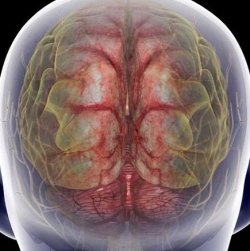
Daniel Wilson discusses the emergence, in the not-so-distant future, of a new class of people whose microchip-enhanced mental abilities may raise questions about what it means to be human.
Over 200,000 people have cochlear ear implants.
Neural implants are outpatient procedures with local anesthetic.
Technology will go to the people who need it the most first.
Over the next decade, new implantable technologies will fundamentally alter the social landscape. We are fast approaching a milestone in the eons-long relationship between human beings and their technology. Families once gathered around the radio like it was a warm fireplace. Then boom boxes leapt onto our shoulders. The Sony Walkman climbed into our pockets and sank its black foam tentacles into our ears. The newest tools are creeping still closer: They will soon come inside and make themselves at home under our skin—some already have.
Prosthetic limbs aren’t the only technology undergoing a renaissance—neural implants are also rapidly maturing, promising to provide mental augmentation rather than physical.
Neural implants, also called brain implants, are medical devices designed to be placed under the skull, on the surface of the brain. Often as small as an aspirin, implants use thin metal electrodes to "listen" to brain activity and in some cases to stimulate activity in the brain. Attuned to the activity between neurons, a neural implant can essentially "listen" to your brain activity and then "talk" directly to your brain.
If that prospect makes you queasy, you may be surprised to learn that the installation of a neural implant is relatively simple and fast. Under anesthesia, an incision is made in the scalp, a hole is drilled in the skull, and the device is placed on the surface of the brain. Diagnostic communication with the device can take place wirelessly. When it is not an outpatient procedure, patients typically require only an overnight stay at the hospital.
Existing neural implants treat serious conditions. Cochlear implants can deliver sound collected from an external microphone directly to the auditory nerve and into the brain. According to the U.S. Food and Drug Administration, over 200,000 people already use cochlear implants world-wide. Other neural implants act as "brain pacemakers," performing deep brain stimulation to treat people with Parkinson’s disease. Yet others can be trained to recognize when epileptic seizures are about to occur and then deliver stimulation to the brain to stop the incipient frenzy of brain activity.
But research is going further.
In the future, it will be feasible for an implant to recognize almost anything. For instance, it could detect inattention. In response, the implant could stimulate the brain toward a state of focused attention. Recently, researchers at the Institute of Neurology at University College London stimulated the brains of human subjects to push the brain toward beta band frequencies associated with focus to study the effects on motor processing, with the hope of helping those with Parkinson’s disease. In an elective setting, a user with this type of implant could potentially choose to stay focused on command, while constantly strengthening circuits of the brain associated with concentration.
The neural implant of the future also could strengthen neural pathways associated with physical tasks. It could recognize "practice" movements and deliver stimulation to associated neurons to help your brain learn faster. Initial users would be people learning to walk again after having a stroke. But you could just as easily be swinging a tennis racket or a baseball bat. Or hitting perfect jump shots. With help from a neural implant, it might be possible for athletes to hone their skills incredibly quickly.
